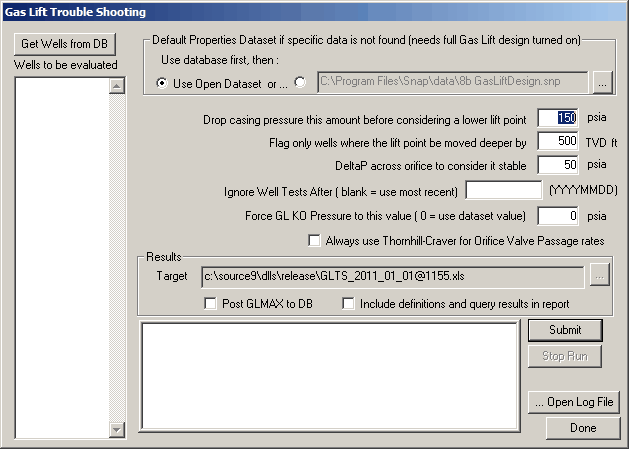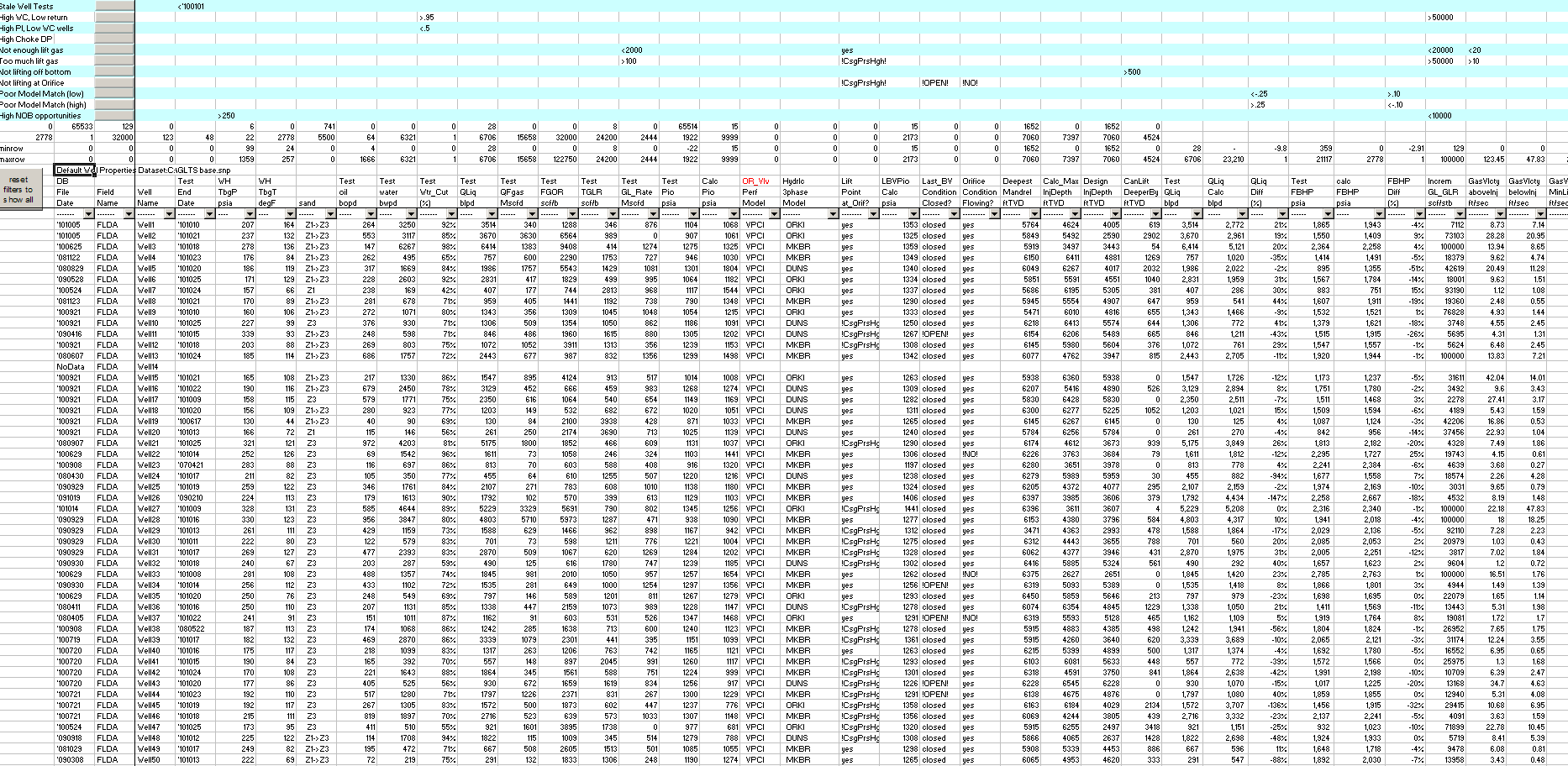|
<< Click to Display Table of Contents >> Utilities Batch Gas Lift Trouble shooting |
  
|
|
<< Click to Display Table of Contents >> Utilities Batch Gas Lift Trouble shooting |
  
|
Utilities: Batch Gas Lift Troubleshooting
This feature will evaluate wells on a database that have been set up for automated troubleshooting. Contact technical support for additional information on this feature.

Once a list of wells has been selected, this feature will evaluate each well for specific behaviors or problems and build a tabular report that can be customized.

The following are detailed descriptions of each column in the Batch Gas Lift Troubleshooting report
Database File Date
Lists date for the most recent file transfer from System Nodal Analysis Program (SNAP) to the Technical Data Base (Database). The wells database dataset is updated with SNAP values for PVT properties, reservoir data, wellbore description, gas passage method, hydraulics 3 phase model correlation, global preferences, etc.
Field Name
Lists the field associated with the well.
Well Name
Name of well in Technical Data Base (Database). Specifies main wellbore and does not identify laterals.
Test End Date
Date of the last allocated and/or good well test used in Batch GLTS routine.
WH TbgP psia
Reports the flowing well head tubing pressure measured during the welltest.
WH TbgT deg_F
Reports the flowing well head tubing temperature measured during the welltest.
sand
Lists the sand the well is completed in and producing.
Test oil bopd
Output is the welltest oil rate.
Test water bwpd
Output is the welltest water rate.
Test Wtr_Cut (%)
Output is the welltest water cut.
Test QLiq blpd
Output is the welltest produced fluid rate.
Test QFgas Mscfd
Output is the welltest Formation gas.
Test FGOR scf/b
Output is the welltest Formation Gas Oil Ratio.
Test TGLR scf/b
Output is the welltest Total Gas Liquid Ratio.
Test GL_Rate Mscfd
Output is the welltest lift gas rate.
Test Pio psia
Output is the surface operating lift gas injection pressure measured during the welltest. (operating casing pressure)
Calc Pio psia
Calculates the surface operating lift gas injection pressure required to inject the well test lift gas rate through the orifice.
| • | Requires lift point depth, orifice size, lift gas rate, wellbore description, produced fluid rate, PVT properties and tubing hydraulics correlation. |
| • | Calculates the pressure in the tubing at the lift point depth. This “downstream” pressure is used to calculate the required “upstream” pressure to inject the welltest lift gas rate. |
| • | The calculated “upstream” pressure at lift point depth is converted to surface pressure based on weight of lift gas. |
| • | Program uses the Rigorous Injection Casing Gradient. |
| • | The Thornhill-Craver calculation for orifice valve gas passage rate can be specified in the Batch GLTS input panel. |
OR_Vlv Perf Model
Output is the specified gas passage method in the wells database dataset. Choices are Valve Performance Clearinghouse, Thornhill-Craver and Winkler.
Hydrlc 3phase Model
Output is the hydraulic model specified in the database dataset.
Lift Point at_Orif?
The program calculates the production tubing pressure (Ppd) and the welltest surface operating lift gas injection pressure (Test Pio) at the orifice valve depth. The program checks if Ppd is less than the Test Pio and outputs “yes” or “no”.
Orifice Condition
The program calculates the production tubing pressure (Ppd) and the surface operating lift gas injection pressure (Test Pio) at the orifice valve depth. The output is “Stable” if the lift gas injection pressure is 50 psi greater than the flowing tubing pressure. The output is “Un-stable” if the difference is less than 50 psi. Output is “Backcheck” if the difference is zero psi or less. The GLTS input panel allows the user to specify the “DeltaP across orifice to consider it stable”. Default is 50 psi.
LBVPio Calc psia
Calculates the surface opening pressure (Pio) of the Lowest Bellows Valve (LBV).
| • | Calculates the flowing tubing pressure at depth of the LBV based on database dataset and hydraulics correlation. |
| • | Calculates the LBV dome pressure at depth (Pvcd) based on Test Rack Opening (TRO) pressure and wellbore temperature. |
| • | Calculates the LBV opening pressure at depth (Piod) using the Force Balance Equation, flowing tubing pressure at depth and Pvcd. |
| • | Translates the LBV Piod pressure to surface Pio based on weight of lift gas. |
Last_BV Condition
The calculation compares the LBV Pio to the test Pio. The LBV is closed if the surface operating lift gas injection pressure measured during the welltest (Test Pio) is less than the surface opening pressure of the LBV. Program outputs either “closed” or “open”.
Deepest Mandrel ft TVD
Output is the depth of the deepest mandrel in the wellbore.
Calc_Max InjDepth ft TVD
Calculates the maximum lift point depth for available casing pressure. Reports that depth in ft TVD.
| • | Calculates casing gradient based on user defined gas lift design pressure Kick Off Pressure. The GLTS input panel default is the dataset value. |
| • | Drops casing pressure a user specified amount on the Batch GLTS input panel (default is 150 psi). This pressure drop accounts for the loss in casing pressure to close unloading valves. (5 valves at 30 psi/valve = 150 psi) |
| • | Adjust casing gradient for pressure drop. |
| • | Calculate the tubing gradient based on injecting the well test lift gas rate at the bottom GL Mandrel depth. |
| • | Reports the intersection of tubing gradient and adjusted casing gradient. |
| • | Calculation is constrained by depth of tubing tail not by bottom GL Mandrel depth. |
Design Inj Depth ft TVD
Output is the depth of the lift point from the database dataset. Normally this point is the orifice valve depth.
CanLift DeeperBy ft TVD
| • | Compares the depth of the deepest mandrel in the wellbore with the calculated maximum lift point depth (Calc_Max InjDepth) and stores the lesser value. |
| • | Output is the difference between the lesser value and the depth of the current lift point from the database dataset (Design Inj Depth). |
| • | Output is constrained by user specified value in GLTS input panel. “Flag only wells where the lift point can be moved deeper by _____ TVD ft”. Default value is 500 ft. |
Test QLiq
Reports the welltest produced fluid rate.
QLiq Calc blpd
Calculates FBHP based on welltest data, database dataset, hydraulics correlation and wellbore description. Uses the IPR curve from the database dataset to determine produced fluid rate (Qliq) based on FBHP.
QLiq Diff Prcnt
Output is the percent variance from the QLiq Meas and the Qliq Calc.
Test FBHP psia
Output is the flowing bottom hole pressure calculated from well test data and the database dataset.
calc FBHP psia
Output is the flowing bottom hole pressure based on calculated produced fluid rate (Qliq Calc).
FBHP Diff (%)
Output is the percent variance from the Test FBHP and the calc FBHP.
IGOR scf/stb
Program uses the well test, the database dataset and IPR curve to graph total produced fluid rate as a function of lift gas plus formation gas (Total gas vs Total Produced Fluids).
| • | Plots the welltest data point on the graph. |
| • | Add 100 Mscfd lift gas and calculate a new FBHP. |
| • | Calculate new produced fluid rate from IPR. |
| • | Calculate new total gas rate using the wells TGLR. |
| • | Plot new data point on graph of Total Gas vs Total Produced Fluids |
| • | Account for the water cut of well. |
| • | Report the change in Total Gas per unit of change in oil production. |
| • | Units are scf/stb |
| • | This is the Incremental Gas Oil Ratio (IGOR) of the well. |
GasVlcty aboveInj ft/sec
Output is the gas velocity in the tubing at 100’ TVD above the lift gas injection point.
GasVlcty belowInj ft/sec
Output is the gas velocity in the tubing at 100’ TVD below the lift gas injection point.
GLVlcty MinLift ft/sec
Output is the minimum lift gas velocity to keep liquid droplets moving up the wellbore.
P_Res well model
Output is the reservoir pressure from database dataset.
PI_BH bpd/psi
Calculate the wells productivity index from well test rate, reservoir pressure and well test FBHP.
OilRate Benefit bopd
Moves the lift gas injection point to the CanLiftDeeperBy depth and calculates a FBHP. The oil rate for this FBHP is determined from the wells IPR curve and database dataset.
Tst_Sep press psi
Output is the test separator pressure measured during the welltest.
FTP – Tst_Sep press psi
Output is the flowing tubing pressure minus the test separator pressure. Wells tested with excessive back pressure or operating with a restricted production choke will have a reading greater than ~ 20 psi.
Well Name
Repeats the name of well in Technical Data Base (Database). Specifies main wellbore and does not identify laterals.
This list was provided by Grant Dornan who does not warranty its accuracy or fitness for particular purpose.
*